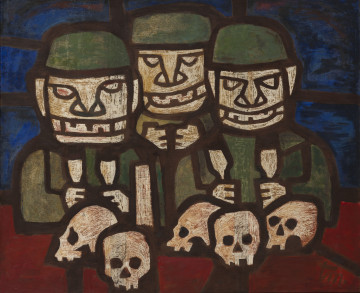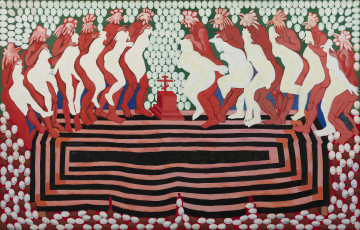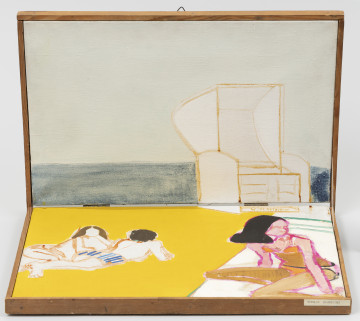
The People Killers
1946
National Museum in Szczecin
Part of the collection: European classics of modernity
Moscow-born Marian Tomaszewski (1904-1968) began his education in a Russian gymnasium but moved to Poland with his parents after the October Revolution. He passed his baccalaureate examinations at the Juliusz Słowacki State Teachers' Seminary in Lublin (1926). It enabled the future painter to find employment in the educational sector, in which he was active almost his entire professional life. After receiving his diploma from the Warsaw Academy of Fine Arts, he began teaching the art of drawing in the capital city's secondary schools. During the Nazi occupation, the artist returned to Lublin, where he became an instructor at the art courses of Janina Miłosiowa (1896-1983) and subsequently at the German School of Painting and Drawing. Alongside his teaching career, Tomaszewski was involved in underground cultural life. After the liberation of the city, he created the foundations of an institution with the Provisional Board of the Trade Union of Visual Artists, of which he became president. His experiences in Lublin led him to be entrusted with organising artistic life in Szczecin, where he arrived in September 1945. At the Provincial Department of Culture and the Arts, he was a specialist in the arts; at the local branch of the ZZAP - he was a vice president; he also founded the Society for the Promotion of Culture in Western Pomerania and the Free College of Visual Arts (from 1947 the School of Visual Arts, and from 1948 the National Visual Arts Cultural Centre), of which he became director. Wartime memories and pioneering work became an influential theme in his works, including the features stained glass design: Bolesław I the Brave in Western Pomerania (1947). The work is part of a series of monumental works created or planned for the Provincial Office building in Szczecin. The 1911 building, designed in the historicist trend drawing on the style of the Northern Renaissance, was given a Polish makeover between 1946 and 1947 by partially replacing the German interior decorations with scenes from the region's Piast-Gryffice history. Tomaszewski, for example, created the wall paintings Bolesław I the Brave hammering the pillars, Anna Jagiellon's wedding and Western lands as a buckler, which were, however, taken away after a year. The stained glass windows, on the other hand, were never made. Szymon Piotr Kubiak
Author / creator
Object type
painting
Technique
oil technique
Material
chipboard
Origin / acquisition method
purchase
Creation time / dating
Creation / finding place
Owner
Muzeum Narodowe w Szczecinie
Identification number
Location / status

1946
National Museum in Szczecin

1989 — 1990
National Museum in Szczecin

1969
National Museum in Szczecin
DISCOVER this TOPIC
National Museum in Lublin
DISCOVER this PATH
Educational path